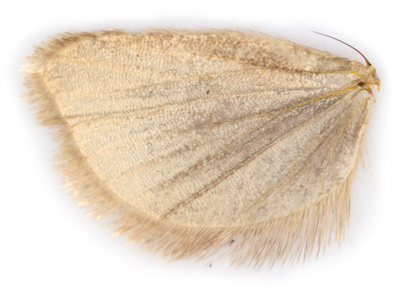49.158 Hedya ochroleucana (Buff-tipped Marble)
ws: 16-21mm (BTM, MBGBI5.2), fw: 7.5-10mm (Sterling & Parsons); Jun-Jul; roses (Rosa spp); common in England and Wales
ID: Basal 2/3 of forewing marbled brown, blue-grey and black with some whitish patches, apical 1/3 pale ochreous-yellow. Similar to H.nubiferana and H.pruniana in both of which the apical 1/3 is white rather than ochreous-yellow and they often show a patchy grey suffusion in this area which is not seen in H.ochroleucana. Apotomis betuletana is also similar and usually has a white apical 1/3, but may have a pale ochreous apical 1/3 when the forewing pattern is indistinguishable from H.ochroleucana. In male A.betuletana a hair-pencil on the hind-tibia is recessed in a groove; in male H.ochroleucana this groove is absent (and the hair-pencil is shorter). In the hindwing of both sexes V3&4 are connate in A.betuletana, separate in H.ochroleucana (Ref. MBGBI5.2).
Male genitalia: In Hedya species the sacculus/neck/cucullus complex are of fairly even width and the sacculus is fully fused into this complex; in Apotomis species the sacculus has a distinct spined apical lobe, the neck is relatively narrow and the cucullus relatively expanded. The Hedya species differ in the arrangements of spines on the sacculus, in the shape of the basal cavity and in the shape of the uncus. H.ochroleucana has 2 adjacent clusters of spines on the ventral margin of the sacculus and a smaller cluster on its dorsal margin, the basal cavity is J-shaped (on right, inverted J on left) and the uncus is fairly evenly broad with a notched apex.
Male genitalia: In Hedya species the sacculus/neck/cucullus complex are of fairly even width and the sacculus is fully fused into this complex; in Apotomis species the sacculus has a distinct spined apical lobe, the neck is relatively narrow and the cucullus relatively expanded. The Hedya species differ in the arrangements of spines on the sacculus, in the shape of the basal cavity and in the shape of the uncus. H.ochroleucana has 2 adjacent clusters of spines on the ventral margin of the sacculus and a smaller cluster on its dorsal margin, the basal cavity is J-shaped (on right, inverted J on left) and the uncus is fairly evenly broad with a notched apex.
§1 Romansleigh, Devon; 25/06/2016; male; fw 10.2mm; to light
§2 Romansleigh, Devon; 28/06/2016; male; fw 9.4mm; to light
§3 Foulness, Essex; 08/07/2023; female; fw 8.7mm
All images © Chris Lewis
§2 Romansleigh, Devon; 28/06/2016; male; fw 9.4mm; to light
§3 Foulness, Essex; 08/07/2023; female; fw 8.7mm
All images © Chris Lewis
Page published 06/12/2016 (§1-2) | §3 added 04/10/2023


















